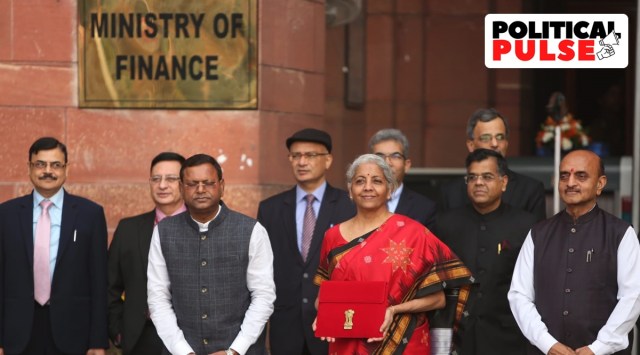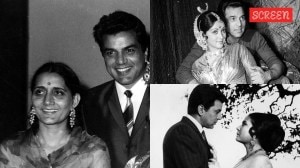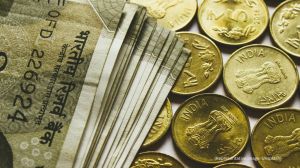Union Budget: Pranam to Mishti, Modi govt continues its fondness for acronyms
Cutting fertilisers, and promoting mangrove plantation and organic bio-resources are latest objectives framed in catchy slogans
 Finance Minister Nirmala Sitharaman before presenting the Union Budget 2023-24 in Parliament. (Express Photo by Gajendra Yadav)
Finance Minister Nirmala Sitharaman before presenting the Union Budget 2023-24 in Parliament. (Express Photo by Gajendra Yadav) The Union Budget 2023-24 again reflected the Narendra Modi government’s love for acronyms, with Finance Minister Nirmala Sitharaman unveiling several more in her speech.
These include PM PRANAM, which stands for PM Promotion of Alternate Nutrients for Agriculture Management Yojana, which will incentivise states to reduce the use of chemical fertilisers.
Earlier, The Indian Express had reported that the scheme may not have a separate budget and would be financed by the “savings of existing fertiliser subsidy” under schemes run by the Department of fertilisers.
Sitharaman also announced mangrove plantation along the coastline under a new MISHTI scheme.
Investment of Rs 10,000 crore was announced in the Budget on Wednesday for the Gobardhan Scheme “for promoting circular economy”. The acronym stands for the Galvanizing Organic Bio-Agro Resources Dhan Scheme, or GOBAR-DHAN, and is implemented under the Swachh Bharat Mission Gramin-Phase 2.
Some of the other acronyms the Modi government has come up with for schemes include UDAN, or Ude Desh Ka Aam Nagrik, launched in April 2017 – to improve connectivity to and develop less-used regional airports.
SHAKTI, launched in November 2022, stands for Scheme to Harness and Allocate Koyla Transparently in India, its name self-explanatory, with koyla standing in for coal.
SAGAR is the short form for the government’s goal regarding maritime cooperation, which is ‘Security And Growth for All in the Region’. It was announced in March 2015.
USTTAD is short for Upgrading Skills and Traditional Arts/Craft for Development, again a self-explanatory name aimed at promoting traditional crafts, and supporting their practitioners, which was announced in May 2015.
GIAN or Global Initiative of Academic Networks aims to enhance academic interactions between India and the world, and was announced formally in November 2015. PRAGATI stands for Pro-Active Governance and Timely Implementation – essentially a platform to review the progress of various government schemes and address problems – started in March 2015. SWIFT or Single Window Interface for Facilitating Trade, aims to achieve the government’s push for minimum government with trade clearance through a single “window”, and was launched in April 2016.
PRASHAD is the name for Pilgrimage Rejuvenation and Spiritual, Heritage Augmentation Drive, introduced in 2015, which aims to develop pilgrimage destinations. GEM or the Government E-marketplace is the name for a scheme for public procurement through the Internet, launched in August 2016.
One of the first announcements of the new government was the renaming of the Planning Commission. By January 2015, it was known as NITI Aayog – or National Institution for Transforming India (NITI) Aayog.
Apart from schemes, Modi has shown a fondness for numbers to put forth his “vision”. In his Independence Day speech last year, the Prime Minister came up with the “Panch Pran of Amrit Kaal” – or five commitments for the next 25 years till 2047, when India completes 100 years of Independence. These include “removing any trace of a colonial mindset, taking pride in our roots, unity amongst workers, especially women, and the duties and responsibilities of citizens”.
In September 2014, months after he came to power for the time, in his address to the Indian diaspora at Madison Square Garden in New York City, Modi singled out “three Ds” — “democracy, demographic dividend, and demand” — as the three unique strengths of India that will take it to new heights.
In February 2016, kickstarting the “Make in India” week in Mumbai, Modi built on his idea of three Ds and added one more, deregulation, saying these would help India become an easy place to do business. At the Bloomberg Global Business Forum in New York in September 2019, Modi had a different take on the four Ds. “Today, there are four important factors of India’s growth story which are difficult to find in the world together. These 4 factors are democracy, demography, demand, and decisiveness,” he said.
The following year, in September, Modi addressed a conclave on school education in the 21st century that the Ministry of Education organised under the National Education Policy (NEP) 2020. At the event, the PM emphasised the importance of “five Es” – “Engage, Explore, Experience, Express, and Excel”.
Earlier that year, in June 2020, Modi spoke of the “three Ps” in his address at the inauguration of the 95th Annual Plenary Session of the Indian Chamber of Commerce. “People, Planet and Profit are interlinked to each other. All three can simultaneously flourish and co-exist,” he said.
The PM also employs “formulae” in his speeches. One of his most-known ones is using the mathematical formula “(a+b)2” to explain the ties between India and Canada. The relations between the two countries, the PM explained in Toronto in 2015, were like the “2ab” that appears when the formula is expanded.
In 2017, Modi while launching a digital system developed to help the Supreme Court go paperless, the PM said if the country had to adapt to new technologies and stay ahead of the curve, it would have to follow the equation “IT+IT = IT”, or Information Technology and Indian talent equals “India Tomorrow”.
During the campaign trail ahead of the 2014 general elections, Modi gave the acronym “ABCD” to attack the Congress – “A for Adarsh Ghotala, B for Bofors Ghotala, C for Coal ghotala, D for Damad ka ghotala”. He earlier accused the Congress of “RSVP” model of governance – “Rahul, Sonia, (Robert) Vadra and Priyanka”.
Addressing a rally in Kathua, Jammu, on the campaign trail, the PM said Pakistan had to its benefit “3 AK-47s“: The AK-47 rifle, then Defence Minister A K Antony of the Congress and AAP supremo Arvind Kejriwal.



- 011 day ago
- 021 day ago
- 031 day ago
- 0417 hours ago
- 051 day ago




























